Abstract
Plasma membrane glycoproteins from Dictyostelium discoideum amoebae at three stages of early development were digested with Pronase and endoglycosidase H and fractionated by gel filtration. This gave three classes of glycans (polysaccharides, endoglycosidase H-resistant glycopeptides, and endoglycosidase H-released oligosaccharides), which were tested for their ability to block agglutination of amoebae from vegetative, aggregation (8-hr), and late-aggregation (13-hr) stages of development. The endoglycosidase H-resistant glycopeptides from 8-hr cells inhibited agglutination of disaggregated 8-hr cells but not vegetative or 13-hr cells. The 8-hr polysaccharide and endo H-sensitive oligosaccharides did not inhibit. The glycopeptides from 8-hr cells were resolved into five species by electrophoresis in borate-containing buffer. Two of these had agglutination-inhibiting activity, and three did not. None of the glycan fractions from vegetative or 13-hr cells inhibited agglutination of vegetative, 8-, or 13-hr cells. These data implicate specific cell surface glycans in aggregation-stage intercellular cohesion and suggest that both these glycans and receptors for them are developmentally regulated.
Full text
PDF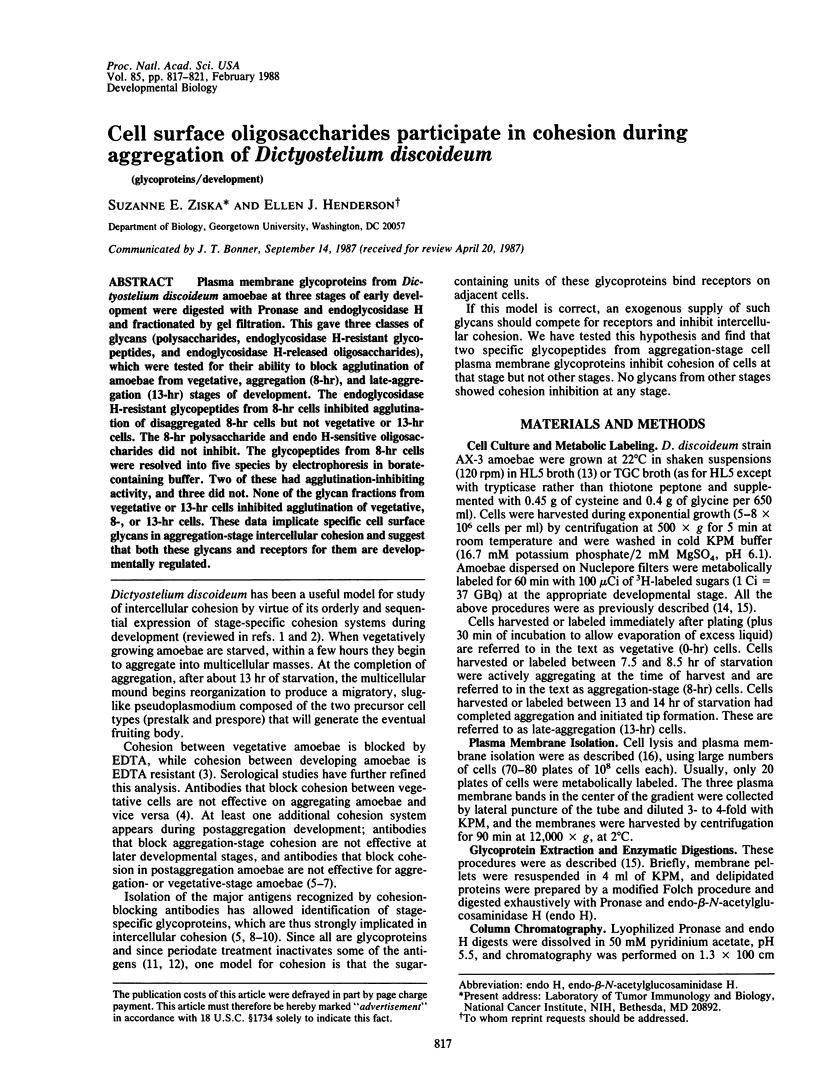
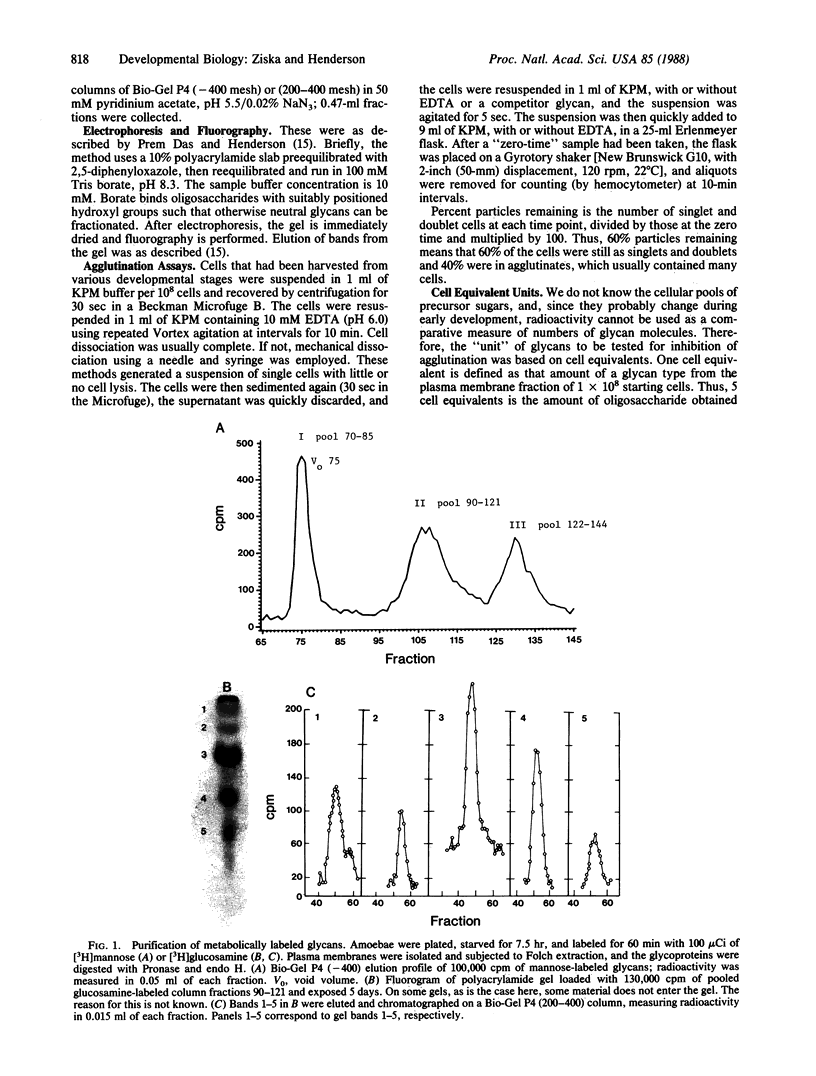
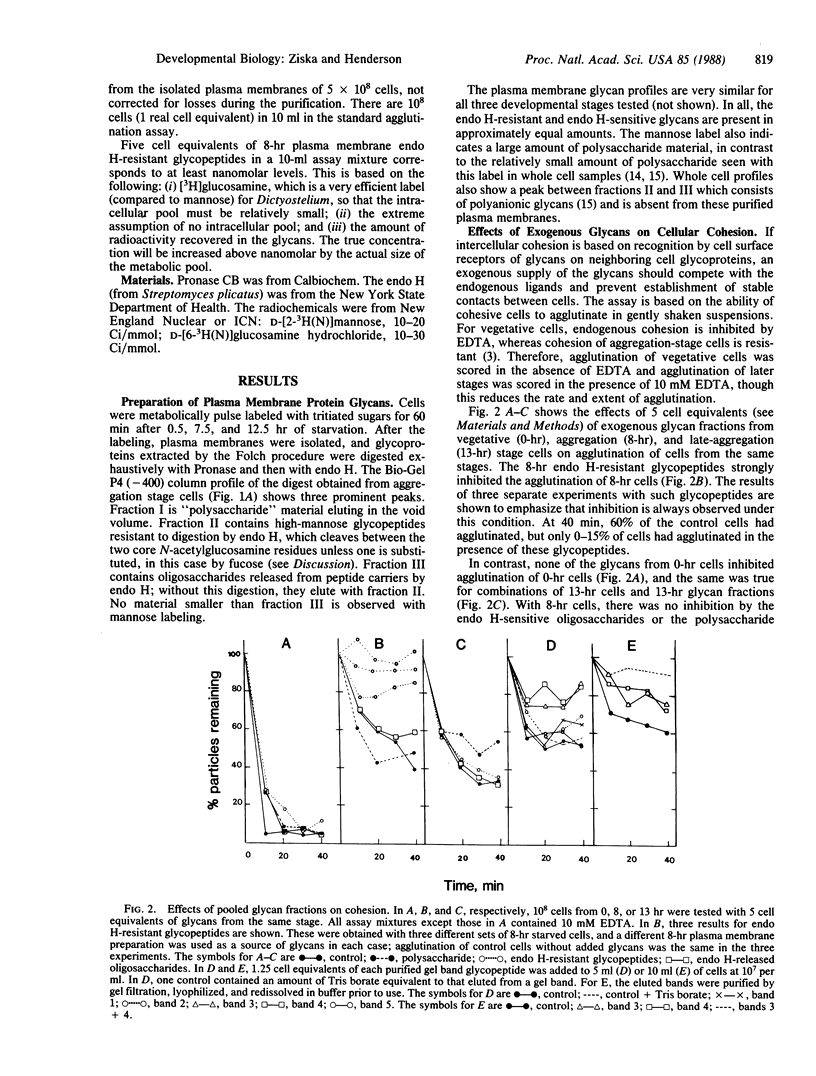
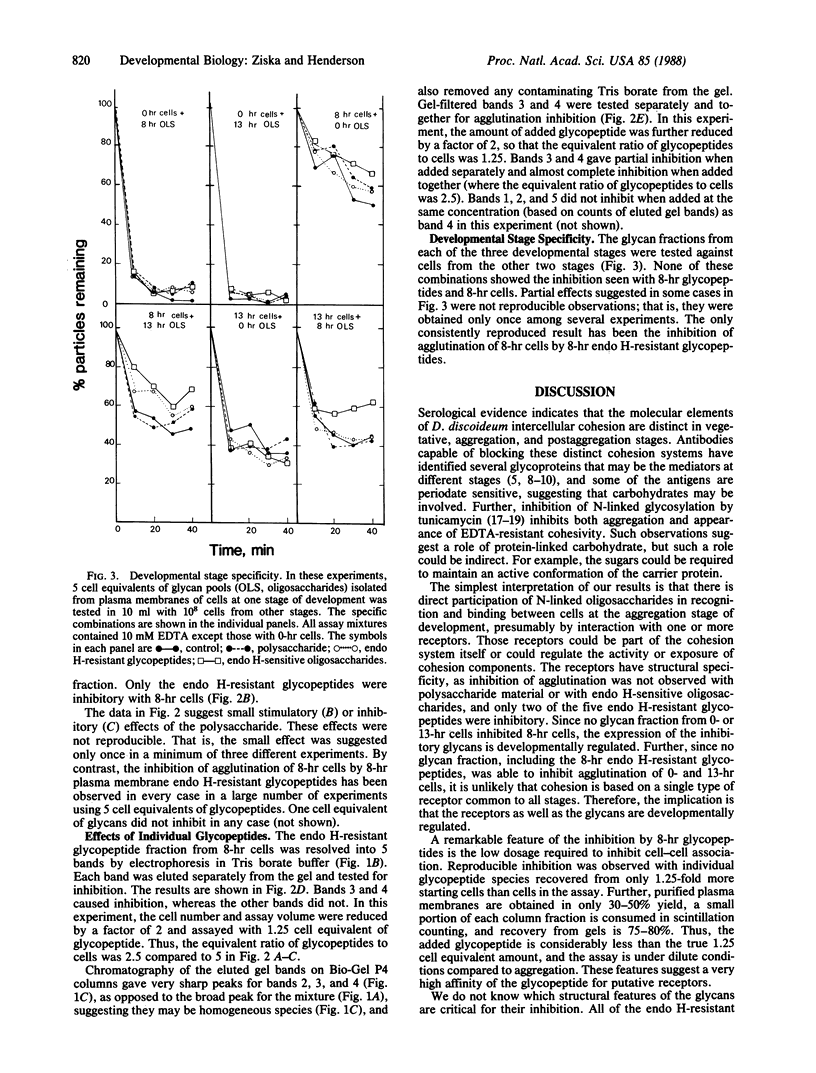
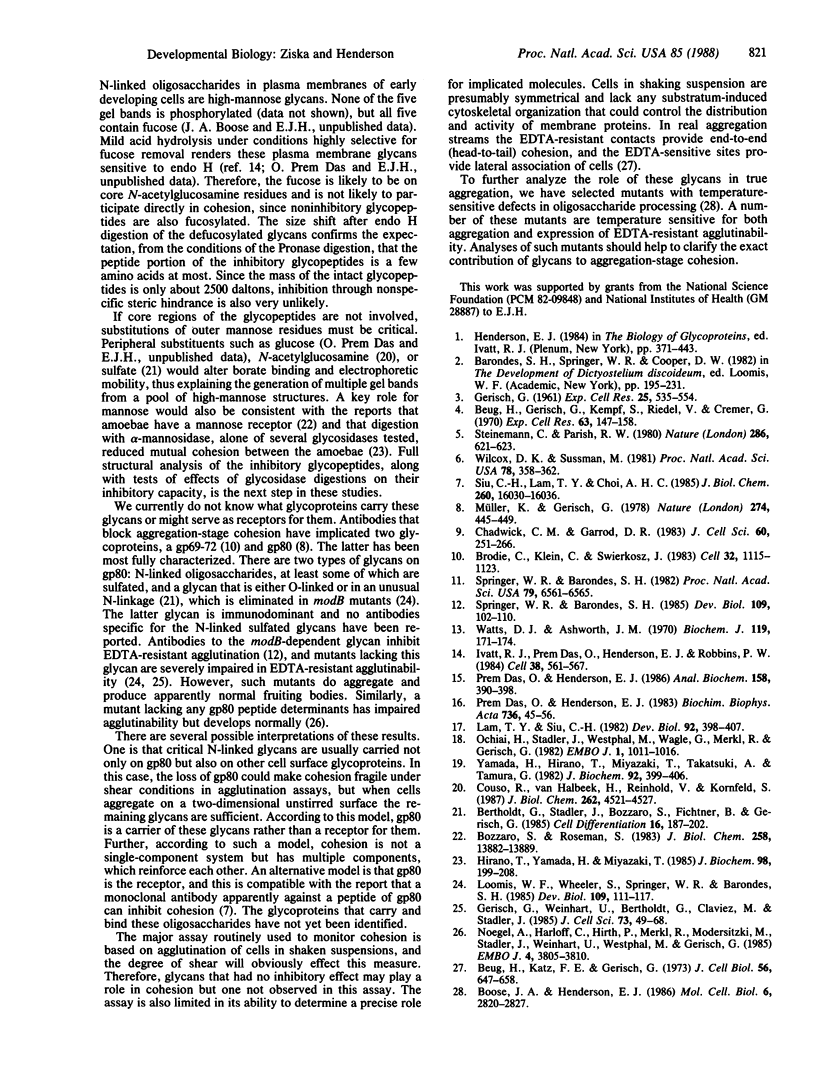
Images in this article
Selected References
These references are in PubMed. This may not be the complete list of references from this article.
- Bertholdt G., Stadler J., Bozzaro S., Fichtner B., Gerisch G. Carbohydrate and other epitopes of the contact site A glycoprotein of Dictyostelium discoideum as characterized by monoclonal antibodies. Cell Differ. 1985 May;16(3):187–202. doi: 10.1016/0045-6039(85)90516-0. [DOI] [PubMed] [Google Scholar]
- Beug H., Gerisch G., Kempff S., Riedel V., Cremer G. Specific inhibition of cell contact formation in Dictyostelium by univalent antibodies. Exp Cell Res. 1970 Nov;63(1):147–158. doi: 10.1016/0014-4827(70)90343-5. [DOI] [PubMed] [Google Scholar]
- Beug H., Katz F. E., Gerisch G. Dynamics of antigenic membrane sites relating to cell aggregation in Dictyostelium discoideum. J Cell Biol. 1973 Mar;56(3):647–658. doi: 10.1083/jcb.56.3.647. [DOI] [PMC free article] [PubMed] [Google Scholar]
- Boose J. A., Henderson E. J. Sulfate suicide selection of Dictyostelium discoideum mutants defective in protein glycosylation. Mol Cell Biol. 1986 Aug;6(8):2820–2827. doi: 10.1128/mcb.6.8.2820. [DOI] [PMC free article] [PubMed] [Google Scholar]
- Bozzaro S., Roseman S. Adhesion of Dictyostelium discoideum cells to carbohydrates immobilized in polyacrylamide gels. I. Evidence for three sugar-specific cell surface receptors. J Biol Chem. 1983 Nov 25;258(22):13882–13889. [PubMed] [Google Scholar]
- Brodie C., Klein C., Swierkosz J. Monoclonal antibodies: use to detect developmentally regulated antigens on D. discoideum amebae. Cell. 1983 Apr;32(4):1115–1123. doi: 10.1016/0092-8674(83)90295-7. [DOI] [PubMed] [Google Scholar]
- Chadwick C. M., Garrod D. R. Identification of the cohesion molecule, contact sites B, of Dictyostelium discoideum. J Cell Sci. 1983 Mar;60:251–266. doi: 10.1242/jcs.60.1.251. [DOI] [PubMed] [Google Scholar]
- Couso R., van Halbeek H., Reinhold V., Kornfeld S. The high mannose oligosaccharides of Dictyostelium discoideum glycoproteins contain a novel intersecting N-acetylglucosamine residue. J Biol Chem. 1987 Apr 5;262(10):4521–4527. [PubMed] [Google Scholar]
- Das O. P., Henderson E. J. Fluorographic detection of tritiated glycopeptides and oligosaccharides separated on polyacrylamide gels: analysis of glycans from Dictyostelium discoideum glycoproteins. Anal Biochem. 1986 Nov 1;158(2):390–398. doi: 10.1016/0003-2697(86)90566-x. [DOI] [PubMed] [Google Scholar]
- Gerisch G., Weinhart U., Bertholdt G., Claviez M., Stadler J. Incomplete contact site A glycoprotein in HL220, a modB mutant of Dictyostelium discoideum. J Cell Sci. 1985 Feb;73:49–68. doi: 10.1242/jcs.73.1.49. [DOI] [PubMed] [Google Scholar]
- Hirano T., Yamada H., Miyazaki T. Direct implication of surface mannosyl residues in cell adhesion of Dictyostelium discoideum. J Biochem. 1985 Jul;98(1):199–208. doi: 10.1093/oxfordjournals.jbchem.a135259. [DOI] [PubMed] [Google Scholar]
- Ivatt R. L., Das O. P., Henderson E. J., Robbins P. W. Glycoprotein biosynthesis in dictyostelium discoideum: developmental regulation of the protein-linked glycans. Cell. 1984 Sep;38(2):561–567. doi: 10.1016/0092-8674(84)90510-5. [DOI] [PubMed] [Google Scholar]
- Lam T. Y., Siu C. H. Inhibition of cell differentiation and cell cohesion by tunicamycin in Dictyostelium discoideum. Dev Biol. 1982 Aug;92(2):398–407. doi: 10.1016/0012-1606(82)90185-3. [DOI] [PubMed] [Google Scholar]
- Loomis W. F., Wheeler S. A., Springer W. R., Barondes S. H. Adhesion mutants of Dictyostelium discoideum lacking the saccharide determinant recognized by two adhesion-blocking monoclonal antibodies. Dev Biol. 1985 May;109(1):111–117. doi: 10.1016/0012-1606(85)90351-3. [DOI] [PubMed] [Google Scholar]
- Müller K., Gerisch G. A specific glycoprotein as the target site of adhesion blocking Fab in aggregating Dictyostelium cells. Nature. 1978 Aug 3;274(5670):445–449. doi: 10.1038/274445a0. [DOI] [PubMed] [Google Scholar]
- Noegel A., Harloff C., Hirth P., Merkl R., Modersitzki M., Stadler J., Weinhart U., Westphal M., Gerisch G. Probing an adhesion mutant of Dictyostelium discoideum with cDNA clones and monoclonal antibodies indicates a specific defect in the contact site A glycoprotein. EMBO J. 1985 Dec 30;4(13B):3805–3810. doi: 10.1002/j.1460-2075.1985.tb04151.x. [DOI] [PMC free article] [PubMed] [Google Scholar]
- Ochiai H., Stadler J., Westphal M., Wagle G., Merkl R., Gerisch G. Monoclonal antibodies against contact sites A of Dictyostelium discoideum: detection of modifications of the glycoprotein in tunicamycin-treated cells. EMBO J. 1982;1(8):1011–1016. doi: 10.1002/j.1460-2075.1982.tb01286.x. [DOI] [PMC free article] [PubMed] [Google Scholar]
- Siu C. H., Lam T. Y., Choi A. H. Inhibition of cell-cell binding at the aggregation stage of Dictyostelium discoideum development by monoclonal antibodies directed against an 80,000-dalton surface glycoprotein. J Biol Chem. 1985 Dec 15;260(29):16030–16036. [PubMed] [Google Scholar]
- Springer W. R., Barondes S. H. Evidence for another cell-adhesion molecule in Dictyostelium discoideum. Proc Natl Acad Sci U S A. 1982 Nov;79(21):6561–6565. doi: 10.1073/pnas.79.21.6561. [DOI] [PMC free article] [PubMed] [Google Scholar]
- Springer W. R., Barondes S. H. Protein-linked oligosaccharide implicated in cell-cell adhesion in two Dictyostelium species. Dev Biol. 1985 May;109(1):102–110. doi: 10.1016/0012-1606(85)90350-1. [DOI] [PubMed] [Google Scholar]
- Steinemann C., Parish R. W. Evidence that a developmentally regulated glycoprotein is target of adhesion-blocking Fab in reaggregating Dictyostelium. Nature. 1980 Aug 7;286(5773):621–623. doi: 10.1038/286621a0. [DOI] [PubMed] [Google Scholar]
- Watts D. J., Ashworth J. M. Growth of myxameobae of the cellular slime mould Dictyostelium discoideum in axenic culture. Biochem J. 1970 Sep;119(2):171–174. doi: 10.1042/bj1190171. [DOI] [PMC free article] [PubMed] [Google Scholar]
- Wilcox D. K., Sussman M. Serologically distinguishable alterations in the molecular specificity of cell cohesion during morphogenesis in Dictyostelium discoideum. Proc Natl Acad Sci U S A. 1981 Jan;78(1):358–362. doi: 10.1073/pnas.78.1.358. [DOI] [PMC free article] [PubMed] [Google Scholar]
- Yamada H., Hirano T., Miyazaki T., Takatsuki A., Tamura G. Effects of tunicamycin on cell adhesion and biosynthesis of glycoproteins in aggregation-competent cells of Dictyostelium discoideum. J Biochem. 1982 Aug;92(2):399–406. doi: 10.1093/oxfordjournals.jbchem.a133946. [DOI] [PubMed] [Google Scholar]



